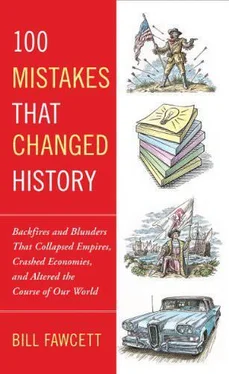Baiting the Barbarians
1300
This mistake involves two great rulers whose lands and ways were very different. It is a story of how one insulting mistake changed the lives of every person in Europe and Asia. It begins with a cruel show of power and ends in millions of deaths.
The first of these rulers was Ala’ ad-Din Muhammad, the emperor of the Khwarezm empire. In the thirteenth century the Khwarezm empire controlled all of central Asia, including today’s Iran, Iraq, Pakistan, and Afghanistan. This was a rich kingdom for it controlled the Silk Road on which all of the trade from China flowed. The taxes paid by the merchants supported palaces and gardens that were the wonders of their time. Khwarezm was also a powerful empire with as many as half a million men, mostly well-equipped and thickly armored horsemen, in a full-time army. Its capital at Samarkand was a center of learning and wealth, featuring many acres of magnificent gardens. It was unquestionably the wealthiest and likely best-armed nation in the world. But having the best-armored and largest army does not always mean you will win every battle.
The second leader was a very different man, though he too commanded a magnificent army. At this time, his highly organized and mobile army was in the process of conquering northern China. This was the man known to his people as “the Perfect War Leader,” or Genghis Khan. Genghis Khan had spent most of his life uniting the Mongols and other steppe tribes into a single force. At this point in history, the Mongols also controlled a stretch of the incredibly profitable Silk Road. This was the section that ran between China and Khwarezm across the Mongolian steppes. With his armies busy in wealthy and populous China, Genghis went to great efforts to ensure all of the caravans that ran on this route traveled safely—and paid substantial taxes for the privilege. For some time, this courtesy was returned by the Khwarezm as it seemed to be in everyone’s self-interest. Genghis Khan showed how pleased he was with the arrangement by sending gifts and messages of friendship to Ala’ ad-Din Muhammad.
Then the Khwarezm got nervous. The Mongols were being too successful in conquering areas of China. They feared they would be next. A friendly barbarian was one thing, but one who was successful in battle could be a threat. Suddenly, and likely accurately, it was decided that the growing number of Mongols who accompanied the caravans from China were spies. The result was a series of attacks on suspected caravans not by bandits, but Khwarezm soldiers.
Genghis Khan was not happy. He had gone to great lengths to protect the Khwarezm merchants and their caravans in his lands, but suddenly Khwarezm was slaughtering his merchants. He sent a caravan with an ambassador and other important Mongol nobles to Samarkand to protest. When it arrived, the Mongol ambassador demanded not only that the attacks stop but that Ala’ ad-Din pay restitution for the goods and lives already lost.
For weeks, the Khwarezm emperor did not formally respond. The details of this time have been lost, but we can surmise. Perhaps the Mongol ambassador became strident or maybe the Khwarezm just felt secure with a half-million-man army, a border protected by high mountains, and the bulk of the Mongol army still busy in China. Or maybe Ala’ ad-Din just had a sadistic sense of humor. Whatever the reason, his response was clear not only in its meaning but also in the total disdain it demonstrated.
The emperor gathered up everyone from the Mongol party, and in front of his court lit their beards on fire. Since the men had full beards, it seems likely every face was horribly scarred and many of the Mongols were blinded. Then, to make sure the message was clear, the Khwarezm emperor also beheaded the ambassador before sending the survivors back to Genghis Khan. It was an insult, a direct and unequivocal insult. It was also one of the ways you declared war. This was also perhaps the greatest mistake any ruler has made in history.
Genghis Khan moved as quickly as possible, avoiding the normal passes between the two lands and taking a different route. In 1219, almost 100,000 horsemen were suddenly within Khwarezm while that empire’s army was still waiting to stop Genghis in the wrong place. Within a matter of months, those 100,000 Mongols had completely obliterated five times their number of Khwarezm soldiers. In retaliation, every city in the empire was not just conquered but destroyed, and its population killed or enslaved. Mostly the people were mercilessly slaughtered. Glorious, rich, sophisticated Samarkand was turned into rubble, and every man, woman, and child inside the city slain. By the end of Genghis Khan’s attack, there simply was no more Khwarezm. As much as three-quarters of the population were dead. Not a single city remained in the heart of the empire; there was no army, and its ruler had fled. Ala’ ad-Din Muhammad is said to have died of fright 2,000 miles from Samarkand, still hounded by 20,000 Mongol riders led by their most brilliant commander, Subotai.
So great was the destruction caused by this burning of the beards that even today lands that were fertile centers of civilization 700 years ago are still impoverished tribal areas. If Ala’ ad-Din had instead placated Genghis Khan, the Mongols might well have not felt the need to turn west. Poland and Hungary would have been spared a crippling invasion, Russia would not have suffered from centuries of debilitating occupation, and NATO would not now be fighting in the wastes of Afghanistan.
The Black Death and the Revenge of the Cats
1348
The Black Death was one of the worst pandemics in human history. It led to one of the most self-defeating slaughters in history. Cats were rumored to be the source of the plague. In those panicky times, no more than a rumor was needed. All over Europe the house cats were slain. Cat lovers today can take consolation in the slaughter along with the ghosts of murdered cats. They had their revenge in the form of millions of additional Europeans succumbing to a horrific death.
The killing of tens of thousands of cats during this time, encouraged primarily by the Catholic Church, caused the flea-infested rodent population in Europe to soar. Those rats most likely carried the bubonic plague, passing it on to humans through fleas that had been on the host rat, become infected, and then bitten humans. There were no insect sprays and no protection. Fleas and other pests were everywhere in the newly growing cities all over the continent. It is estimated that perhaps half of the population in Europe succumbed to this horrendous death from 1348 to 1352.
The bubonic plague was the most common type of infection seen during the Black Death. It was characterized by black spots on the chest and black swelling under the armpits and at the tops of the legs. The buboes, or swollen lymph nodes, turned black, oozed pus, and bled. Of those contracting the disease, four out of five died within eight days. The second most common type of infection seen at this time was the pneumonic plague, which affected the lungs, causing the victims to choke to death on their own blood. This type of plague had about a 95 percent mortality rate. The plague struck and then killed so quickly that the Italian writer Boccaccio said its victims often “ate lunch with their friends and dinner with their ancestors in paradise.” It is no wonder that even the hint of the plague caused a panic. Not only did cats suffer, but often Jews and other minorities were blamed and murdered.
Now, cats were not always considered the “diabolical creatures” that Pope Gregory IX declared them to be in a papal letter in 1232. The ancient Egyptians had developed elaborate ways to store large amounts of grain and other food. Rats and mice were attracted and could damage much of the crop. The Egyptians found that cats were natural predators of the rats and could be used to protect the stores of food. Cats eventually moved into Egyptian households, and they became thought of as godlike and were revered and worshiped. Eventually in Egypt killing a cat was considered an extremely serious offense, punishable by death. The Romans were introduced to cats by the Egyptians, and they were the first European group to keep cats primarily as pets. But the animals were still valued for their ability to keep rodent populations down.
Читать дальше












